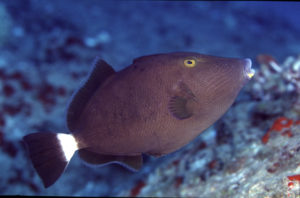
Bridled triggerfish (Sufflamen fraenatus). Photo: John Hoover.
One of the best things about diving in one area for years is that we get to know a few of the fish as individuals. That’s not as easy as it sounds. In most cases, one yellow tang looks just like the next yellow tang, one Picasso triggerfish looks like every other Picasso triggerfish – each fish resembles others of its species.
Luckily for us, there are a few ways that we are occasionally able to identify a fish as an individual:
1. The fish has a defect of some kind – a fin missing; a bite taken out of it that is permanent; a distinctive color marking; buck teeth (yes, we really knew a Hawaiian Dascyllus this way).
2. The fish is the only one of its kind in an area (see our recent Clown triggerfish article).
3. The fish exhibits a unique behavior that none of its contemporaries does.
The Fish in Question
The fish in this article is in the second category – it is the only bridled triggerfish within a 40 square foot area at a particular dive site that we frequent.
When we approach, we see this triggerfish swimming out in the open. As we get closer he/she eventually slips into the same hole every time. If we put our hand near the hole, he/she makes a thumping sound to scare us away. This is not a unique behavior; all triggerfish that we know of do this. Without even touching the fish we can feel the percussive wave through the water and hear the sound, which is like a loud heartbeat.
Apparently, triggerfish make this sound by beating their pectoral fins against the sides of the body. Since the fish has a swim bladder inside for buoyancy, the beating of the fins against the body is like beating a drum. A living musical instrument!
But that is not the exciting part of this story…
When we take divers to this site, our divemaster, AJ, loves to talk about this fish and how it is going to behave when it sees us. She practically acts out the part of the triggerfish at first minding its own business, then seeing us, then getting nervous, then eventually tucking into its hole, and then drumming against its body to make us go away. She always tells the story as if the triggerfish is a “she,” but of course we have no idea if this fish is male or female. So we sometimes give her a hard time about referring to the fish as a she.
The Sex of the Triggerfish is Revealed
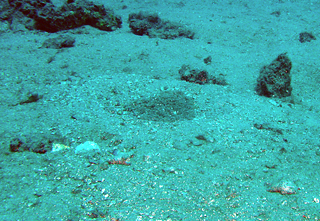
Bridled triggerfish egg mass. Eggs are the dark mass inside the bowl-shaped depression in the sand. Photo P. Fiene.
Last month, when we visited this fish, it did something a little strange. It tucked only part-way into its hole. That seemed odd, but when we came closer it tucked in all the way, so all seemed normal. After hearing the “scary” drumming sound we backed away from the hole and started to continue on our way, but a few feet away from the hole I froze. There in the sand was a big fluffy bridled triggerfish egg mass. While the male is the nest protector in some groups of fish, in triggerfish it is the female who has this duty. This meant that this triggerfish – whose sex we had wondered about for years – was a she!
AJ was up on the boat at the time, but I did my best to aqua-telepathically yell to her – it’s a SHE!!!
As soon as I saw the nest, my divers and I swam about 10 feet away to give her space. She eventually emerged from her hole and got back to defending her eggs. She chased off a tiny goatfish that had snuck in to eat some eggs. She even became bold enough to charge straight at us a few times.
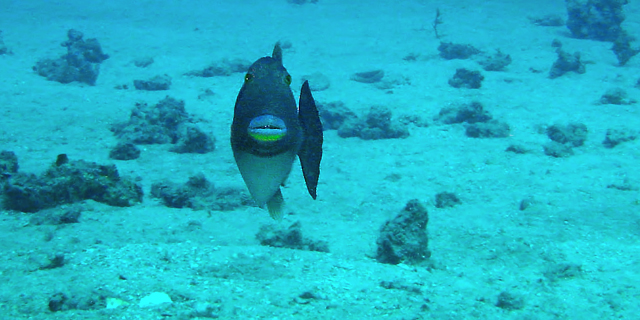
Female bridled triggerfish charging straight at us while defending her egg mass. It is the circular patch right underneath her near the bottom of the photo. Photo P. Fiene.
It took another five minutes before she felt comfortable enough to fan her eggs. She does this by hovering nose-down over the eggs and flapping her pectoral fins. This creates a current that bathes the eggs in water and oxygenates the developing embryos inside the egg capsules. Since bridled triggerfish nests of this same size have been recorded to contain over 90,000 eggs, aeration is critical or the tightly-packed embryos would suffocate.
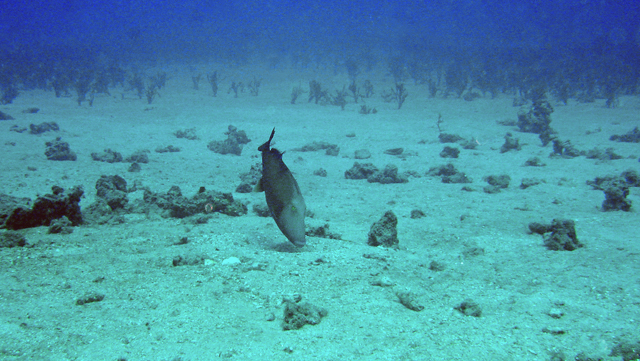
Bridled Triggerfish fanning her eggs. Photo P. Fiene.
Here’s the amazing part. Female bridled triggerfish might lay only a few nests a year – from June-Oct. here in Hawaii. The eggs are laid in the early morning hours and they develop in less than about 15 hours, hatching around sunset. It is one of the fastest egg developments among fish. The odds of us diving at that particular dive site, on one of the few days out of the whole year that she has a nest are so small that it took us over 5 years to find out that she is a she.
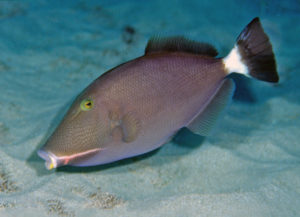
Male bridled triggerfish indicated by the white “bridle” extending from both corners of the mouth. Photo: John Hoover.
Full (embarrassing) disclosure: IF we had carefully read the bridled triggerfish entry in John Hoover’s Ultimate Guide to Hawaiian Reef Fishes, we would have learned that male bridled triggerfish have a white “bridle” running back from the corners of their mouth as shown in the photo to the right.
We could have known which sex our fish was years ago – because our triggerfish has no such bridle :-).
Written by Pauline Fiene. Photos as credited.
***********************

Comments 4
I always enjoy the articles you post. But , I have a question. If she is the only bridled triggerfish in that area, how are the eggs fertilized?
Author
Ahaa! Good question, Wayne! I said that she was the only bridled triggerfish within a 40 square foot area. There is a male just outside of her territory that is probably the “fertilizer” 🙂
Thanks for a great blog post, as usual! I always look forward to these posts, just wish there were more of them :). Cheers!
I’ve noticed that some Bridled Triggers have a white ring around the base of the tail, others don’t. I’ve always assumed, without any evidence, that they all have the ability to turn a white ring on and off. In the photos, your female doesn’t seem to show one. Does she ever display a white ring? How about the male?